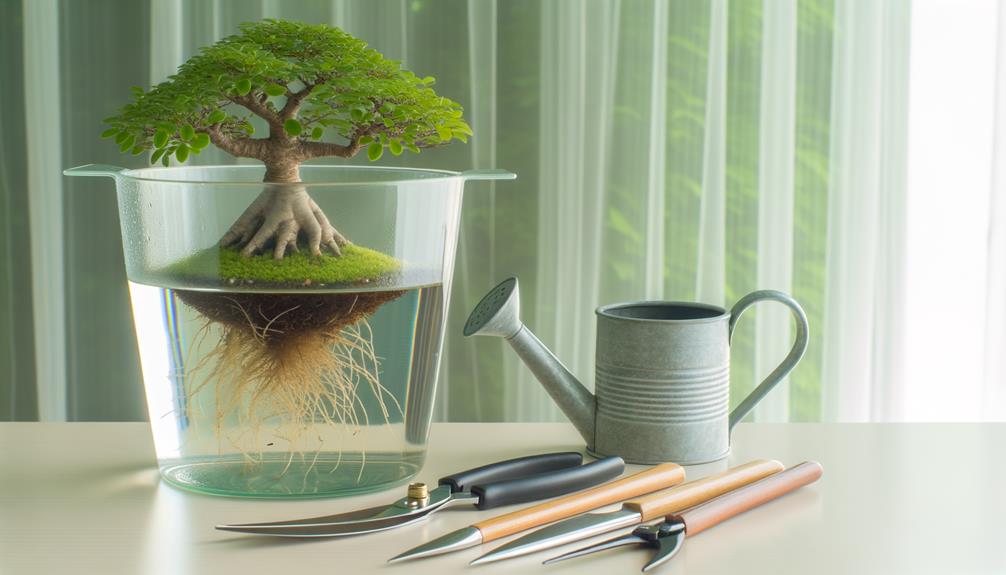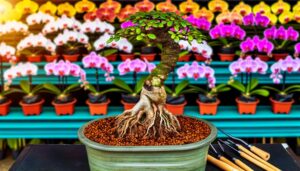How to Grow Bonsai in Water – A Step-by-Step Guide
Yes, bonsai can thrive in water through hydroponic techniques, which involve nurturing plants in a nutrient-rich, water-based solution. Suitable species for hydroponic bonsai include Ficus, Schefflera, Mangrove, and Water Wisteria.
Key components for hydroponic cultivation include balanced pH levels, mineral nutrient solutions, aeration systems, and full-spectrum LED lights. Regular monitoring of nutrient concentrations, water quality, and root health is essential.
Benefits of hydroponics include quicker growth rates, although risks such as root rot and nutrient imbalances must be handled. Delve into the specifics of hydroponic bonsai to master this innovative cultivation method.

Key Takeaways
- Bonsai can grow in water using hydroponic systems with nutrient-rich solutions.
- Water-tolerant species like Ficus and Schefflera are ideal for hydroponic bonsai cultivation.
- Root oxygenation is crucial to prevent root rot in hydroponic bonsai.
- Regular monitoring of pH levels and nutrient concentration ensures healthy growth.
- Hydroponic bonsai require specific equipment like air pumps and LED grow lights.
Understanding Hydroponic Bonsai

Although traditional bonsai cultivation relies on soil, hydroponic bonsai represents a scientific advancement enabling the growth of bonsai trees in a water-based, nutrient-rich solution.
This method utilizes hydroponics, a subset of hydroculture, where plants grow in a controlled environment with mineral nutrient solutions in an aqueous solvent. Essential nutrients such as nitrogen, phosphorus, and potassium are meticulously balanced, ensuring prime growth conditions.
One must monitor pH levels and electrical conductivity to maintain nutrient availability and prevent deficiencies. Additionally, aeration systems provide the necessary oxygen to the root zone, promoting robust root development.
This technique offers precision in nutrient management, reduced risk of soil-borne pests and diseases, and efficient water usage, ideal for sustainable bonsai cultivation.
Types of Bonsai Suitable for Water
Certain bonsai species, such as Ficus and Schefflera, exhibit robust adaptability to hydroponic growth systems due to their tolerance for high moisture environments.
Employing hydroponic methods for these species involves specific nutrient solutions and inert growing media to facilitate best root development.
Effective maintenance and care, including regular monitoring of water quality and nutrient levels, are critical for sustaining the health and aesthetics of hydroponic bonsai.
Aquatic Bonsai Species
Several species of plants have adapted well to growing in water and are ideal candidates for aquatic bonsai. These species thrive in hydroponic environments due to their robust root systems and tolerance to varying water conditions.
Importantly, the following are exemplary choices for aquatic bonsai:
- Ficus (Ficus benjamina): Known for its adaptability and resilience, the Ficus can sustain in water with proper nutrient solutions.
- Mangrove (Rhizophora mangle): This species naturally grows in saline water and can be effectively cultivated in freshwater or marine setups.
- Water Wisteria (Hygrophila difformis): Popular in aquascaping, Water Wisteria's rapid growth and easy maintenance make it suitable for bonsai.
These species exhibit unique physiological traits that facilitate successful aquatic cultivation.
Hydroponic Growth Methods
Adopting hydroponic growth methods for bonsai involves understanding the specific nutrient requirements and environmental conditions that facilitate the best development of water-tolerant species. Suitable bonsai for hydroponic systems include Ficus, Schefflera, and certain varieties of Willow. These species thrive in nutrient-rich, oxygenated water environments.
Key factors include maintaining a balanced pH level (typically between 5.5 and 6.5) and guaranteeing the water contains essential micronutrients such as nitrogen, phosphorus, and potassium. Additionally, adequate light exposure, preferably from full-spectrum LED grow lights, is essential for photosynthesis.
The use of air stones or oxygen pumps is recommended to prevent root rot by ensuring sufficient oxygenation within the water. Proper monitoring and adjustments ensure ideal growth conditions for hydroponic bonsai.
Maintenance and Care
Building on the principles of hydroponic growth methods, maintaining and caring for water-grown bonsai necessitates a keen understanding of the specific needs of species such as Ficus, Schefflera, and Willow, which are particularly suited to aquatic environments.
Effective maintenance involves:
- Nutrient Solution Management: Regularly monitor and adjust the nutrient solution's pH and electrical conductivity (EC) to promote ideal absorption.
- Root Health Monitoring: Inspect roots for signs of rot or disease, ensuring they remain healthy and white, indicative of proper oxygenation.
- Light and Temperature Control: Provide sufficient light, preferably full-spectrum grow lights, and maintain stable temperatures to mimic natural conditions.
These practices promote the sustained health and aesthetic appeal of water-grown bonsai, leveraging hydroponic techniques for superior plant well-being.
Required Equipment and Setup

To successfully cultivate bonsai in water, one must acquire specific tools and materials designed to facilitate hydroponic growth. Essential items include a high-quality hydroponic system, such as Deep Water Culture (DWC) or Nutrient Film Technique (NFT).
Additionally, an oxygenation device, like an air pump with air stones, is imperative to guarantee adequate dissolved oxygen levels. A reliable pH meter and an EC (Electrical Conductivity) meter are vital for monitoring water quality parameters.
Containers should be transparent to allow root visibility and made from non-toxic materials. Lighting systems, preferably full-spectrum LED grow lights, are necessary to provide the appropriate light spectrum.
Lastly, sterile growing media, such as expanded clay pellets or Rockwool, support root structure and nutrient uptake.
Nutrient Solutions for Hydroponic Bonsai
Hydroponic bonsai cultivation necessitates precise management of nutrient solutions to guarantee ideal plant health and growth.
Key considerations include understanding essential nutrient components such as nitrogen, phosphorus, and potassium, accurately balancing pH levels to facilitate nutrient uptake, and selecting efficient nutrient delivery methods like ebb and flow or nutrient film technique.
Proper execution of these factors is critical for sustaining a thriving hydroponic bonsai environment.
Essential Nutrient Components
Essential nutrient components, often delivered through carefully crafted nutrient solutions, are necessary for the successful cultivation of hydroponic bonsai. These solutions must contain a precise balance of macronutrients and micronutrients to ensure optimal growth and development.
- Macronutrients:
Nitrogen (N), phosphorus (P), and potassium (K) are primary macronutrients necessary for photosynthesis, energy transfer, and overall plant health.
- Micronutrients:
Elements such as iron (Fe), manganese (Mn), and zinc (Zn) are required in smaller quantities but are essential for enzymatic functions and chlorophyll production.
- Calcium and Magnesium:
These secondary nutrients play a significant role in cell wall structure and chlorophyll synthesis, respectively.
Accurate dosing and regular monitoring of these nutrient components are crucial for maintaining a thriving hydroponic bonsai environment.
Balancing Ph Levels
Maintaining the correct pH levels in nutrient solutions is vital for the absorption of macronutrients and micronutrients in hydroponic bonsai cultivation. An ideal pH range, typically between 5.5 and 6.5, promotes efficient nutrient uptake and encourages healthy growth. Deviations from this range can result in nutrient lockout, where essential elements become unavailable to the plant. Monitoring and adjusting pH levels with precision tools is necessary for maintaining this delicate balance. Below is a table detailing key pH levels for common nutrients:
| Nutrient | Best pH Range | Symptoms of Imbalance |
|---|---|---|
| Nitrogen (N) | 5.5 – 6.5 | Yellowing of leaves, stunted growth |
| Phosphorus (P) | 5.8 – 6.5 | Purpling of stems, poor root growth |
| Potassium (K) | 6.0 – 6.5 | Marginal chlorosis, leaf curl |
Meeting these parameters will promote robust bonsai development in hydroponic systems.
Nutrient Delivery Methods
Efficient nutrient delivery methods are essential for ensuring best growth and development in hydroponic bonsai systems. Nutrient solutions must be meticulously balanced to provide essential macro and microelements.
Here are three primary methods for nutrient delivery in hydroponic bonsai:
- Nutrient Film Technique (NFT): A thin film of nutrient solution flows over the roots, ensuring constant access to nutrients and oxygen.
- Deep Water Culture (DWC): Plant roots are submerged in nutrient-rich, aerated water, promoting robust growth through direct nutrient uptake.
- Aeroponics: Nutrient solution is misted onto the roots, offering maximum oxygenation and efficient nutrient absorption.
Each method requires precise monitoring of nutrient concentration, pH levels, and oxygen supply to optimize bonsai health and development.
Maintenance and Care Tips

Proper maintenance and care of bonsai growing in water require a thorough understanding of hydroponic principles and diligent monitoring of water quality, nutrient levels, and root health.
It is crucial to regularly test the water's pH, aiming for a range of 5.5 to 6.5 to optimize nutrient absorption. Employing a high-quality hydroponic nutrient solution guarantees that the bonsai receives balanced macro and micronutrients.
Regularly inspect the roots for signs of rot or disease, trimming any damaged areas to promote healthy growth. Ensure sufficient oxygenation of the water through aeration techniques to prevent anaerobic conditions.
Consistent light exposure, ideally 12-16 hours of indirect sunlight or artificial grow lights, is vital for photosynthesis and overall well-being.
Common Challenges and Solutions
Cultivating bonsai in water presents unique challenges, such as nutrient imbalances, root rot, and inadequate oxygenation, which require specific strategies to mitigate. Addressing these issues necessitates a blend of technical expertise and practical solutions.
- Nutrient Imbalances: Utilize a balanced, water-soluble fertilizer designed for hydroponics to ensure optimal nutrient availability. Regularly monitor and adjust nutrient concentrations to avoid deficiencies or toxicities.
- Root Rot: Implement a strict water change regimen and incorporate antifungal agents to prevent fungal infections. Ensure that the roots are not submerged continuously to allow for drying periods.
- Inadequate Oxygenation: Employ air stones or oxygen pumps within the water reservoir to enhance oxygen levels. This promotes healthy root respiration and prevents hypoxic conditions detrimental to bonsai health.
Comparative Growth: Soil Vs. Water

Comparing the growth of bonsai in soil versus water reveals distinct differences in root development, nutrient uptake, and plant health dynamics. In soil, bonsai roots typically exhibit a more sturdy and branching structure, facilitating efficient nutrient absorption. Soil-based cultivation also allows for a more controlled release of nutrients, significantly impacting plant health. Conversely, hydroponic bonsai often show faster initial growth due to the direct availability of nutrients dissolved in water, but may suffer from root rot and nutrient imbalances if not carefully monitored. The following table summarizes these contrasts:
| Aspect | Soil | Water |
|---|---|---|
| Root Development | Sturdy and branching | Faster initial growth, fragile |
| Nutrient Uptake | Controlled release | Direct, requires monitoring |
| Plant Health Dynamics | Stable with proper care | Risk of rot, nutrient imbalances |
These insights guide gardeners in selecting the best growth medium.
Success Stories and Experiments
Numerous case studies and controlled experiments have demonstrated the feasibility of growing bonsai in water, providing valuable insights into best practices and potential challenges. Researchers have identified key factors influencing successful hydroponic bonsai cultivation. These include:
- Nutrient Solutions: Tailored nutrient solutions are essential for maintaining optimal growth and ensuring the bonsai receives necessary minerals.
- Root Oxygenation: Adequate aeration systems must be implemented to prevent root hypoxia, which can lead to root rot and other health issues.
- Water Quality: Consistent monitoring and maintenance of water pH and purity are vital to prevent the accumulation of harmful substances.
These findings underscore the technical requirements necessary for successful hydroponic bonsai cultivation, highlighting both the potential and the precision needed for this innovative approach.
Conclusion
To sum up, cultivating bonsai using hydroponic methods offers a unique approach that can yield impressive results. By selecting suitable species, investing in proper equipment, and adhering to precise nutrient regimens, one can successfully nurture bonsai in water.
However, challenges such as root rot and nutrient imbalances must be vigilantly managed. As the adage goes, 'Where there's a will, there's a way,' and with meticulous care and attention, hydroponic bonsai can thrive alongside their soil-grown counterparts.






